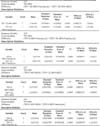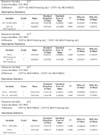Abstract
Background
Object
Methods
Results
Figures and Tables
 | Fig. 1Real-time PCR for differences in stored mediaPMA-stained M. leprae was confirmed by real-time PCR of SYBR green method. A) ΔCt of Freezing solution group (Freezing sol., n=7) was significantly decreased at 4℃ compare to HBSS group (HBSS, n=7)(HBSS 2.14 vs Freezing sol. 1.03, *p<0.05). B) ΔCt of Freezing solution group (Freezing sol., n=7) was decreased at −20℃ compare to HBSS group (HBSS, n=7)(HBSS 1.14 vs Freezing sol. 0.84, NS). Samples were stored for 11 months in HBSS or freezing solution (Mean ± S.E.M; *p<0.05; NS, Not significant; each data point is represented on graphs).
|
 | Fig. 2Real-time PCR for differences in stored temperaturePMA-stained M. leprae was confirmed by real-time PCR of SYBR green method. A) ΔCt of refrigerated group (4℃, n=7) was significantly decreased in HBSS compare to frozen group (−20℃, n=7)(4℃ 2.14 vs −20℃ 1.14, *p<0.05). B) ΔCt of refrigerated group (4℃, n=7) was decreased in freezing solution compare to frozen group (−20℃, n=7)(4℃ 1.03 vs −20℃ 0.84, NS). Samples were stored for 11 months in HBSS or freezing solution. (Mean ± S.E.M; *p<0.05; NS, Not significant; each data point is represented on graphs).
|
 | Fig. 3Real-time PCR for differences in stored mediaPMA-stained M. leprae was confirmed by real-time PCR of probe method. A) ΔCt of freezing solution group (Freezing sol., n=7) was increased at 4℃ compare to HBSS group (HBSS, n=7)(HBSS −0.03 vs Freezing sol. 0.31, NS). B) ΔCt of freezing solution group (Freezing sol., n=7) was increased at −20℃ compare to HBSS group (HBSS, n=7)(HBSS 0.41 vs Freezing sol. 0.6, NS). Samples were stored for 11 months in HBSS or freezing solution (Mean ± S.E.M; NS, Not significant; each data point is represented on graphs).
|
 | Fig. 4Real-time PCR for differences in stored temperaturePMA-stained M. leprae was confirmed by real-time PCR of probe method. A) ΔCt of refrigerated group (4℃, n=7) was increased in HBSS compare to frozen group (−20℃, n=7)(4℃ −0.03 vs −20℃ 0.41, NS). B) ΔCt of refrigerated group (4℃, n=7) was increased in freezing solution compare to frozen group (−20℃, n=7)(4℃ 0.31 vs −20℃ 0.6, NS). Samples were stored for 11 months in HBSS or freezing solution. (Mean ± S.E.M; *p<0.05; NS, Not significant; each data point is represented on graphs).
|
 | Fig. 5Summary in this experimentPMA-stained M. leprae was confirmed by real-time PCR. The results of experiments using real-time PCR of SYBR green showed increase ΔCt deviation compare to real-time PCR of probe method. However, Contrary to SYBR green method, probe method results are unreliable because group of each observed ΔCt.
|




 PDF
PDF ePub
ePub Citation
Citation Print
Print





 XML Download
XML Download